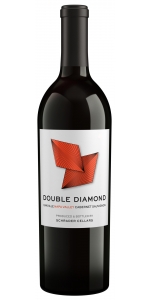Wine from Double Diamond

In 2001, Fred Schrader created Double Diamond as part of his continuing quest to make the best Cabernet Sauvignon that Napa Valley can offer. With the help of acclaimed winemaker Thomas Rivers Brown, this unique expression of the region carries on the tradition of earning critical acclaim and drawing passionate fans that Fred began in 1998 with Schrader Cellars. After a three-year hiatus, Double Diamond returned by popular demand in 2018.
Thomas Rivers Brown followed his interest in winemaking to Napa Valley and was working at a wine shop when he first met Fred Schrader. After a few glasses of wine and a brief but life-changing conversation, Fred knew Thomas was the perfect choice to be his new winemaker, even though Thomas had never made a single barrel of Cabernet Sauvignon. Nineteen years later, Thomas’s dedication to excellence has helped lead Schrader Cellars to an unprecedented record of twenty-seven 100-point scores from the world’s most respected critics.
Carol Schrader created her first label for Schrader Cellars in 2003. Her unwavering commitment to quality was an ideal match for Fred and Thomas, and soon she became an integral part of the brand. Additionally, her designs have graced Double Diamond bottles since the beginning, evolving over the years. Her striking design for the 2016 Double Diamond Oakville Cabernet Sauvignon combines the heritage of the essential wine mark with a dynamic, modern aesthetic and a bold vision for the future.
Double Diamond by Schrader Oakville Cabernet Sauvignon is made from 100 percent Cabernet Sauvignon.
Barrels: 54% new French oak, 46% second-use Schrader Darnajou French Oak
The 2022 Cabernet Sauvignon offers concentration, lively acidity, and refined tannins that have become the hallmark of the 2022 vintage. The nose holds notes of black raspberry, toasted cedar, juicy plum, and pennyroyal mint—a Napa Valley Cabernet Sauvignon signature. The palate is mouthwatering with intricately woven layers of blackberry compote, dark chocolate shavings, oolong tea, and flint. The dynamic flavors carry across the mid-palate in vivid harmony into a long, floral finish. This wine is ready to drink upon release but will cellar well for years to come.
Double Diamond is sourced exclusively from a complement of prime vineyard estates. Sourced from the same famed vineyards as its beloved inspiration Schrader Cellars in Napa Valley’s world-renowned Oakville AVA, including our To Kalon Vineyard.
Double Diamond Oakville Proprietary Red is made from 50% Cabernet Sauvignon, 25% Merlot, and 25% Cabernet Franc.
"The inaugural release of the 2021 Proprietary Red Wine upholds the level of excellence expected from winemaker Thomas Rivers Brown. It expresses a fragrant perfume of ripe red cherry, blueberry, and pomegranate, mingled with bell pepper, iron, and vanilla bean. On the palate, generous red and blue fruits are complemented by blackberry compote, dark chocolate, and espresso. The wine has silky tannins, food-friendly acidity, and a lingering finish. It is ready to drink upon release but will cellar well for years to come."
- back
Selected Options
Wineries
Categories
Pricing
Countries
Regions
Grape Types
Wineries
Organic/Free Shipping
All older vintage wines have been purchased from a single collectors cellar. Pictures can be requested before shipment.
Certified organic, head-trained, dry-farmed field blend of vines planted at the winery in the heart of Napa Valley. Red and black fruits, garrigue, and distinctive black pepper nose. Broad and deep on the palate, with further notes of Provencal herbs and earth; though most definitely a classic Napa wine, it has an almost Southern French sensibility.
Review:
The 2022 Zinfandel Turley Estate is composed of three generations of plantings that commenced in 1996. Medium to deep ruby in the glass, it opens with pure, deep, characteristic aromas of grilled yellow peaches, red cherry, redcurrant, lavender, leather and angostura bitters, revealing finer detail as it spends time in the glass. The palate is massively rich, full-bodied and powerful, with a brooding density that melds with grainy tannins and mouthwatering acidity. The finish is layered, dramatic and perfumed, with an overarching youthful density that will take a few years in bottle to unwind. This is a lovely effort that combines modern density with a classically framed structure.
-Wine Advocate 95 Points






